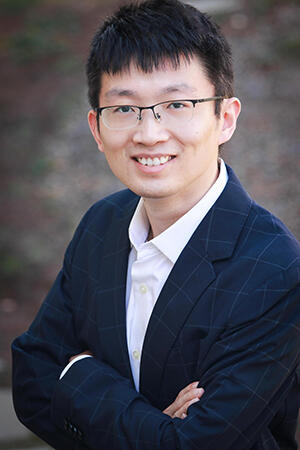
A big goal in the energy field is converting carbon dioxide (CO2) into valuable chemicals or fuels, like methane and ethylene. It’s the hot topic among chemists who study catalysis. However, the formation of these fuels by the specific reaction they study — electrocatalytic CO2 reduction — by way of electrochemistry is somewhat puzzling.
Using electricity to drive chemical reactions requires a microscopic understanding of the reaction as it takes place on a metallic surface (typically gold or copper). Yet, characterizing the mechanisms of a reaction on a large object like copper is difficult to do.
Tianyu Zhu, assistant professor of chemistry, aims to tackle this problem by creating a many-body quantum chemistry framework for modeling catalytic reactions on metallic surfaces, proposed research that has earned him a three-year grant from the Air Force Office of Scientific Research. Zhu was chosen for their 2024 Young Investigator Program for his exceptional ability and promise in theoretical chemistry research.
“In experiments, people struggle to understand how copper–the metal surface–helped those reactions to occur,” said Zhu. “That’s where the computation comes in, where we can simulate how reactions occur on a metal surface to gain more useful, microscopic insights that are very challenging to obtain through experiments. Because some experiments are very challenging to do, the only tools that one may rely on for understanding catalytic mechanisms are these calculations.”
Computational chemists are developing different sorts of methods for this problem. Still, existing methods do not yet have the accuracy to distinguish one reaction mechanism from another with good reliability, Zhu explains.
“My proposal aims to raise the current tool to the next level, where we can develop a computational framework that is more robust, more reliable, and can guide us towards a predictive accuracy,” said Zhu “meaning we can perform this calculation and confidently say, ‘We know the mechanism is A, B, or C.’”
To achieve this, he aims to develop a constant-potential quantum embedding method for electrocatalysis at metal-liquid interfaces and to formulate a multireference Green’s function theory suitable for describing bond breaking and forming on metal surfaces. With this new tool, he expects to elucidate catalytic mechanisms and active sites in selected electrochemical CO2 reduction.
For Zhu, the end goal is to use his new computational method to reveal design strategies for discovering improved catalysts to convert CO2 into useful fuels.
However, getting there is still a ways off. He explains, “copper has low efficiency. So, it doesn’t really have any industry use. But in order to get better catalysts, we must understand [them] first. I hope that with my new computational methods, maybe entering into year three of this project, we will be able to simulate this interesting reaction and understand all its complicated mechanisms.”
Tianyu Zhu is a theoretical chemist. He obtained his Ph.D. in chemistry in 2018 from the Massachusetts Institute of Technology, where, under the supervision of Prof. Troy Van Voorhis, he developed a many-pair expansion method that systematically improves approximate density functional theory calculations and studied charge/energy transfer mechanisms in organic light-emitting diode systems. He completed his postdoctoral research at Caltech with Prof. Garnet Kin-Lic Chan, where he developed many-body theories for describing quantum properties in solid-state materials. He came to Yale as a faculty member in 2022.
Zhu’s research aligns with Yale University’s campaign science priority of quantum technology as his computational techniques apply to the design of heterogeneous solid-state materials for such technology.
Learn about the Zhu Group.